This update provides an overview of gray wolf conservation and management activities in Washington during October 2022.
Program updates and coordination
Reward for information about poisoned wolves increases to $53,900
For the past eight months, the Washington Department of Fish and Wildlife (WDFW) Police have been investigating six wolf mortalities within the Wedge pack territory in Stevens County. WDFW Police began the investigation in February, and it is ongoing. Toxicology results revealed all six wolves died from ingesting poison.
The investigation remains active, and the Department encourages anyone who might have relevant information to report it confidentially by calling WDFW's poaching hotline, 877-933-9847, or by texting a tip to 847411.
The following organizations are offering rewards totaling $53,900 so far for information that leads to a conviction in the case of the poisoning of Stevens County wolves:
Center for Biological Diversity
Conservation Northwest
Defenders of Wildlife
Humane Society of the United States
Kettle Range Conservation Group
Northwest Animal Rights Network
Sierra Club – Washington Chapter
Washington Wildlife First
Western Watersheds Project
Gray wolves are listed as endangered under state law throughout Washington. In the western two-thirds of the state, they are also listed as endangered under the federal Endangered Species Act. Under state law, the illegal killing of a wolf or other endangered fish or wildlife species is a gross misdemeanor, punishable by up to one year in jail and a fine of up to $5,000.
- WDFW continues to support the Conflict on Workinglands Conservation Innovation Grant (CoW-CIG) research team’s evaluation of the effectiveness of range riding at reducing conflicts between livestock and carnivores. In October, WDFW staff and the PhD student spent several weeks in northeastern Washington collecting ~60 trail cameras and shaving cow tails. Trail camera data will be processed starting in 2023.
Outreach and education
- Several WDFW staff attended the International Wolf Symposium in Minneapolis, Minnesota in October. The International Wolf Symposium (held every four years) hosts the world's top wolf biologists in plenary sessions and more than 100 oral and poster presentations on all research topics related to wolves. Ben Maletzke, WDFW’s statewide wolf specialist, was an invited symposium speaker and gave a presentation on Washington’s wolf recovery to approximately 400 wolf biologists, researchers, managers, and others interested in wolves at the symposium.
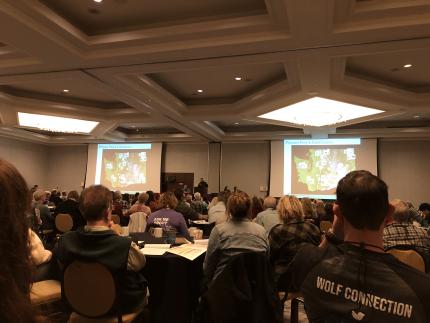
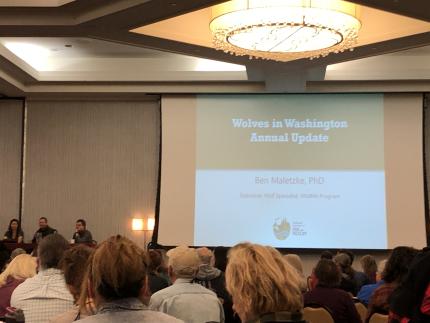
- Gabe Spence, WDFW wolf biologist, gave a presentation on wolves in Washington and wolf capture/handling at a Wildlife Handling and Chemical Immobilization course taught by Dr. Mark Johnson of Global Wildlife Resources and hosted by Wolf Haven International.
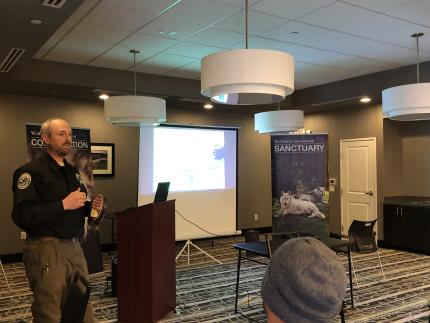
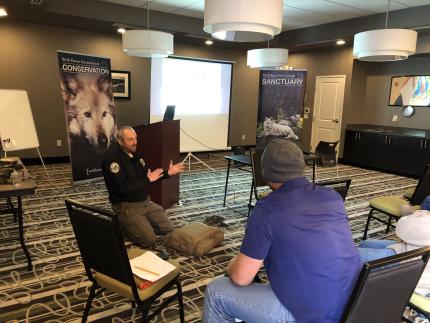
- People often talk about wolves being at the top of the food chain when it comes to carnivores, or that they are “apex” predators. In Washington, however, we are seeing a phenomenon that has been relatively uncommon in other states--some interesting interactions between cougars and wolves. WDFW published a blog post on this topic on Oct. 26.
Current population status and proactive conflict mitigation
The year-end minimum population count for 2021 was at least 206 known wolves in 33 known packs including at least 19 breeding pairs. Annual wolf population surveys are conducted in the winter because wolf populations experience the least amount of natural fluctuation during this time. Counting the population at the end of each year allows for comparable year-to-year trends at a time of year when the wolf population is most stable. The year-end minimum population count for 2022 will be released in April 2023.
Reports of remote camera images or videos, wolf tracks, or sightings from the public are extremely helpful in locating previously undocumented wolf activity and potential new packs on the landscape. Please take photos of wolves or wolf sign (use some way to measure the size of a track) and upload them to the wolf reporting page via the following link: https://wdfw.wa.gov/species-habitats/at-risk/species-recovery/gray-wolf/observations
Definitions: A “pack” is defined as two or more wolves traveling together in winter, and a “breeding pair” is defined as at least one adult male and one adult female wolf that raised at least two pups that survived until December 31. In any given year, the number of packs will always be greater than or equal to the number of breeding pairs. The known territories and more information for each pack can be viewed by clicking the pack name.
Beaver Creek pack
No activity to report.
Butte Creek pack
No activity to report.
Carpenter Ridge pack
No activity to report.
Columbia pack
No activity to report.
Dirty Shirt pack
No activity to report.
Dominion pack
No activity to report.
Goodman Meadows pack
No activity to report.
Grouse Flats pack
No activity to report.
Huckleberry pack
No activity to report.
Leadpoint pack
Updates for the Leadpoint pack were provided on Oct. 5, Oct. 10, and Oct. 13.
Lookout pack
No activity to report.
Loup Loup pack
No activity to report.
Navarre pack
No activity to report.
Onion Creek pack
No activity to report.
Salmo pack
No activity to report.
Shady Pass pack
No activity to report.
Sherman pack
No activity to report.
Skookum pack
No activity to report.
Smackout pack
Updates for the Smackout pack were provided on Oct. 3, Oct. 5, Oct. 7, and Oct. 13.
Stranger pack
A wolf was found dead in the Stranger pack territory during the month of October. A necropsy did not reveal evidence of illegal killing; the cause of death remains under investigation.
Sullivan Creek pack
No activity to report.
Teanaway pack
No activity to report.
Togo pack
No activity to report.
Touchet pack
No activity to report.
Tucannon pack
No activity to report.
Vulcan pack
No activity to report.
Wedge pack
No activity to report.
Miscellaneous/lone wolves
WDFW staff continued to monitor a collared dispersing male wolf (originally from the Naneum pack) and an uncollared wolf (unknown age and sex) traveling in Yakima and Klickitat counties.
During late summer, an adult cow was found dead in a large pasture where the dispersing Naneum wolf had been frequenting. The local WDFW Wildlife Conflict Specialist conducted a necropsy of the carcass and determined that the cause of death was not due to a wild carnivore depredation. The Wildlife Conflict Specialist secured the carcass with electric fencing until the livestock producer was able to remove the carcass from the landscape. Securing a carcass with electric fencing serves to prevent wolves and other carnivores from scavenging on a carcass and becoming habituated to gaining access to food in an area where livestock are actively being pastured.
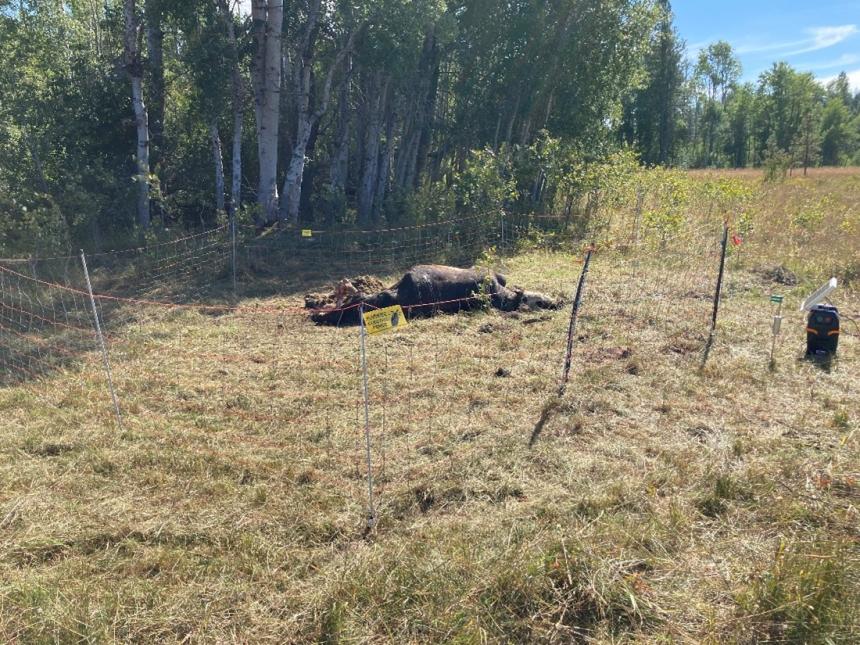
Note: The Frosty, Nason, Nc’icn, Keller Ridge, Strawberry, and Whitestone pack territories are within Confederated Tribes of the Colville Reservation (CTCR) lands and are managed under tribal authority. Information regarding these packs is proprietary and reported at the discretion of the CTCR.
Mortalities
- As reported on Oct. 13, WDFW lethally removed a yearling female wolf on Oct. 10 from the Smackout pack territory.
- As noted above, a wolf was found dead in the Stranger pack territory during the month of October.
- As of this update, WDFW has documented 22 wolf mortalities in 2022.
Depredation activity
In 2021, 76% of known wolf packs were not involved in any documented livestock depredation.
WDFW documented five wolf depredation events in October, higher than the average (2.2) from 2017-2021.
Please report any suspected livestock depredations or the death or harassment of wolves to the WDFW Enforcement Hotline at 1-877-933-9847.
Below is a summary of packs with documented depredation activity within the past ten months (some packs have depredation history prior to the current ten-month window; this timeframe is considered based on guidance from the wolf-livestock interaction protocol (PDF)).
|
Pack |
Depredation date |
Depredation type |
Proactive non-lethals |
Ten-month window |
Agency lethal removal actions |
|
Grouse Flats |
8/12/22 |
Confirmed mortality of steer |
Yes |
6/12/23 |
|
|
|
8/30/22 |
Confirmed mortality of steer |
Yes |
6/30/23 |
|
|
Leadpoint |
8/22/22 |
Confirmed mortality of calf |
Yes |
6/22/23 |
|
|
|
9/1/22 |
Confirmed mortality of calf |
Yes |
7/1/23 |
|
|
|
9/16/22 |
Confirmed mortality of cow |
Yes |
7/16/23 |
|
|
|
9/19/22 |
Confirmed injury of calf |
Yes |
7/19/23 |
|
|
|
9/19/22 |
Confirmed injury of calf |
Yes |
7/19/23 |
Adult male removed 9/27/22; adult female removed 9/28/22 |
|
|
9/30/22 |
Confirmed injury of cow and calf (calf died from injuries) |
Yes |
7/30/23 |
|
|
|
10/7/22 |
Confirmed mortality of cow |
No |
8/7/23 |
|
|
Lookout |
5/20/22 |
Confirmed mortality of two lambs |
Yes |
3/20/23 |
|
|
Smackout |
8/17/22 |
Confirmed mortality of calf |
Yes |
6/17/23 |
|
|
|
8/20/22 |
Confirmed injury of calf |
Yes |
6/20/23 |
|
|
|
8/27/22 |
Probable injury of calf |
Yes |
6/27/23 |
|
|
|
8/28/22 |
Confirmed mortality of calf |
Yes |
6/28/23 |
|
|
|
8/31/22 |
Confirmed mortality of two calves |
Yes |
6/30/23 |
Juvenile male lethally removed 9/8/22 |
|
|
9/26/22 |
Probable mortality of calf |
Yes |
7/26/23 |
|
|
|
10/3/22 |
Confirmed injury of calf |
Yes |
8/3/23 |
|
|
|
10/6/22 |
Confirmed injury of calf |
Yes |
8/6/23 |
|
|
|
10/8/22 |
Confirmed injury of calf |
Yes |
8/8/23 |
Yearling female removed 10/10/22 |
|
|
10/12/22 |
Confirmed mortality of calf |
Yes |
8/12/23 |
|
|
Stranger |
7/28/22 |
Probable injury of calf |
No |
5/28/23 |
|
|
Teanaway |
11/8/21 |
Confirmed injury of calf |
Yes |
9/8/22 |
|
|
Togo |
5/17/22 |
Confirmed mortality of calf |
Yes |
3/17/23 |
|
|
|
5/18/22 |
Confirmed injury of calf |
Yes |
3/18/23 |
|
|
|
6/8/22 |
Confirmed mortality of calf |
Yes |
4/8/23 |
|
|
|
6/12/22 |
Confirmed injury of calf |
Yes |
4/11/23 |
Yearling female lethally removed 6/14/22; adult male lethally removed 6/17/22 |
|
Vulcan |
4/30/22 |
Confirmed mortality of calf |
Yes |
2/28/23 |
|